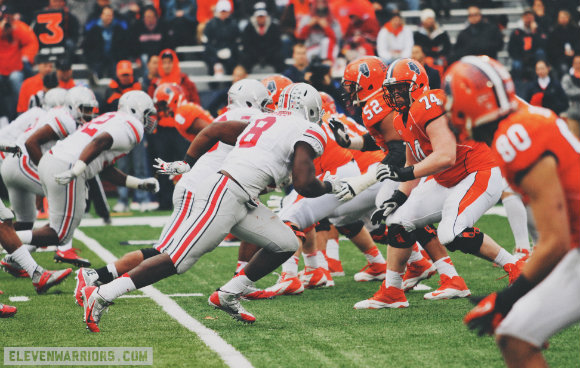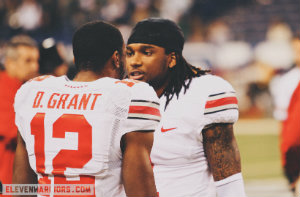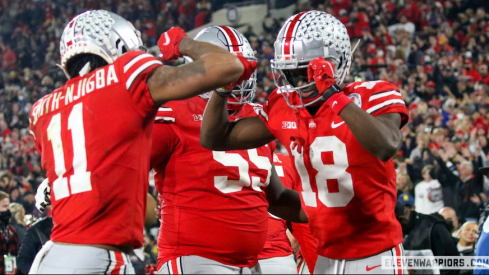
It's part one of our final opponent statistical preview of the 2013 season, and we'll be previewing the scarier matchup first: the Buckeye defense versus Tajh Boyd and Sammy Watkins' offense.
So we know already that Sammy Watkins is awesome. We also know that the Buckeye secondary has been shredded by mediocre passers all season. How can the Buckeye defense possibly hold against a top tier quarterback in Tajh Boyd?
However, the lesser told story is that the Clemson offense is surprisingly inconsistent, with more efficient defenses stymieing Chad Morris's offense for stretches. This is apparent when looking at the Tigers' drive efficiency, especially in comparison with other elite BCS bowl team offenses. The Clemson offense is tied for the third-lowest points per possession total for BCS bowl teams at 2.72. Furthermore, Clemson is "only" 17th in offensive F/+.
This warrants a deeper look into the Clemson offensive numbers to find the root of the Tigers' inconsistency as well as the matchups the Buckeyes must fear the most.
| Pts/Play | Yards/Point | Yards/Play | Pts/Poss | Ex. Plays | Turnovers | |
|---|---|---|---|---|---|---|
| Ohio State Defense | .300 | 17.0 | 5.10 | 1.58 | 42(17th) | +7 |
| Clemson Offense | .502 | 12.5 | 6.28 | 2.72 | 67(34th) | +4 |
Clemson has a great but not elite offense that happens to match up extremely well against the Buckeye defense.
Boyd passed for 3473 yards at 9.3 yards per attempt and nine interceptions. While only 34th overall in plays of 20+ yards, Clemson is 18th overall in passing plays of 20+ yards with 54 of their 67 explosive plays coming through the air. Obviously this is the primary worry for Fickell and Withers: the Buckeyes have allowed long pass plays to the likes of Devin Gardner and Conner Cook over the past two games – how will they defend against a quarterback who actually excels in creating explosive passing plays?
The good news is that the Tigers are much less efficient and explosive on the ground. The leading rusher, Roderick McDowell is a senior that averaged 5.4 yards per carry, though the Tigers were unable to create big rushing plays (just 13 of 20+ yards, good for 84th overall) after Andre Ellington left for the NFL.
Successful opponents have played cover 1, cheated defenders into the gray area, and brought a safety into the box to load up against an already less talented run game. By shutting down the Tigers' rhythm on standard downs, Boyd's passing is much less effective on third and long. In fact, the Clemson offense is at its deadliest when it is able to attack with play action on standard downs and the opposing defense is already geared to stop the run; for the opposing defense, shut down the run and the threat of play action is significantly mitigated.
So while the Buckeye defense is weakest in pass defense, it's critical that the Ohio State run defense limits McDowell so that the Tiger passing game cannot benefit from play action on standard downs.
 Roby and Grant will be on center stage.
Roby and Grant will be on center stage. - McDowell has been Clemson's only threat on the ground. Their second-leading rusher is Boyd, who has 284 total yards with an average of 2.1 yards per carry.
- Clemson is 16th with 145 passing plays of 10+ yards and 18th in passing plays of 20+ yards. This is an explosive aerial attack and any semblance of a running game will open up new pages of the Clemson playbook through the air.
- While we might have nightmares of the long bombs to Sammy Watkins, the more common threat might be short passes and screens that go for 10+ yards. That's why the 145 pass plays of 10+ yards should be extremely unsettling.
- Clemson has a bit of a fumbling problem with 12 on the year. That, and Boyd's nine interceptions, lower Clemson's overall turnover margin, even though it's positive overall.
- For being one of the best offenses the Buckeyes have seen all season, their inconsistency is evident in their first down rate of 71%, meaning that roughly 29% of their drives fail to gain a first down at all. This is 48th in the country.
- The Clemson offense is more explosive than efficient, and like the Buckeyes' offense, not built for methodical drives. Only 15% of Clemson's drives have ten or more plays (64th in the country).
- Clemson has been the beneficiary of quite a number of short field drives, or drives at midfield or the opponent's half. 16% of Clemson's drives have started this way, which is one of the highest percentages in the country.
What remains to be seen is whether the Buckeyes can limit the passing game, both on short passing plays on standard downs and off of play action. What the season's data does suggest, however, is that the Clemson run game is much less potent than the pass game and the offense is much more geared towards explosive plays than efficient ones or methodical drives.
Besides shutting down the run game and limiting short passes, the Ohio State defense must do what it can to take advantage of Clemson's periods of inefficiency. That means capitalizing on points off of turnovers, playing the field position game to make Clemson drive the entire field, and above all, not letting Sammy Watkins get behind the safeties.

